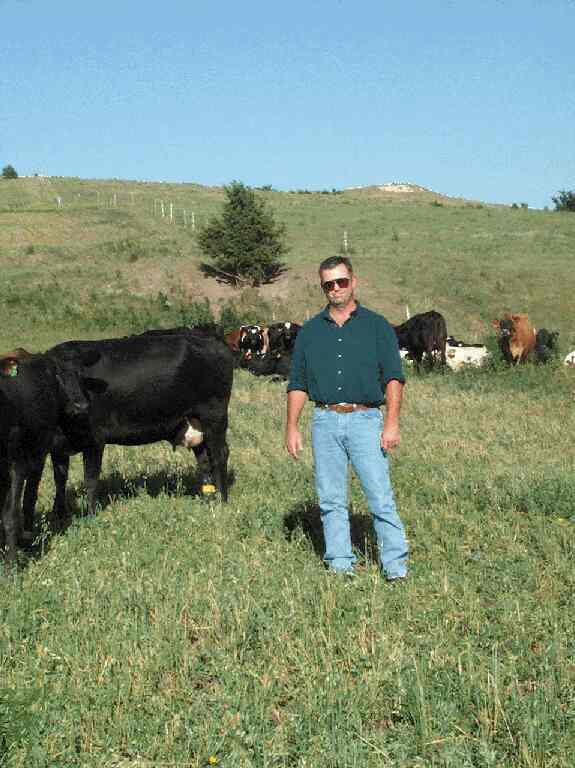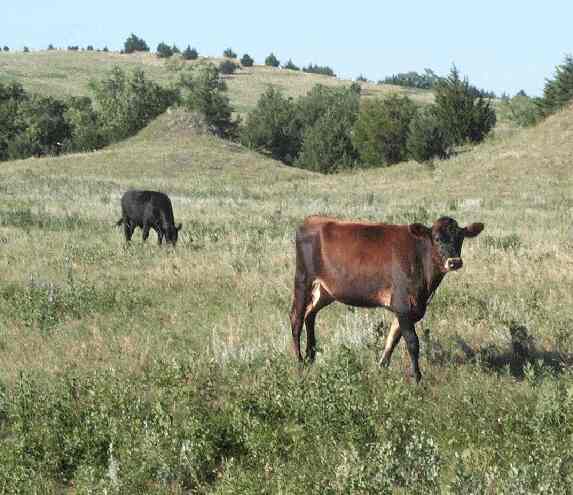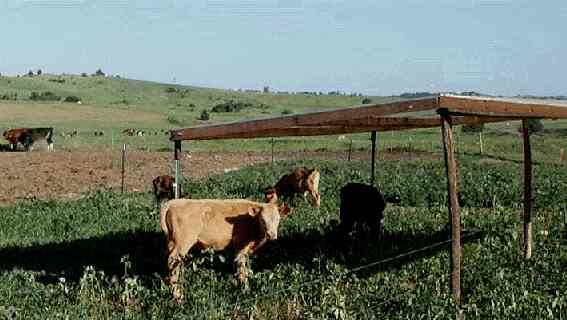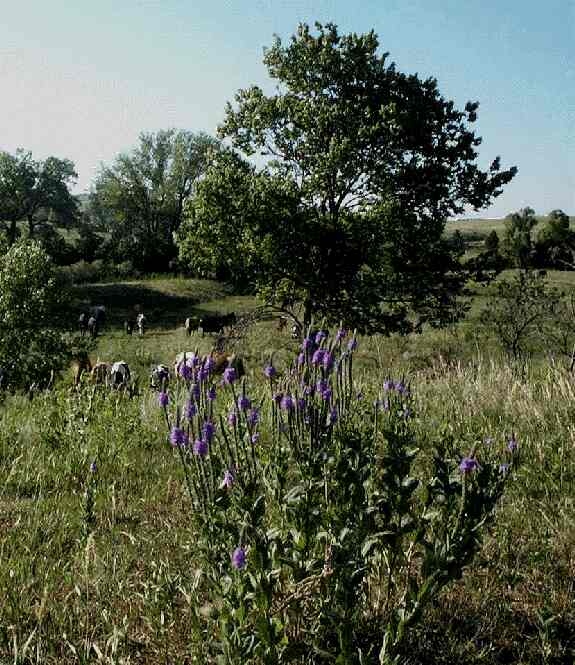Loup Valley Dairy
2000 Environmental
Annual Report
Document Links: Policy
/ Loup Valley Dairy Environmental Aspects
/ Environmental Regulations / Overall Loup Valley
Environmental Goals
/ Action Plan for 2000 and Performance
/ Action Plan for 2001 / Contact
Information
Return to: IERE Home / IERE
Sustainable Agriculture Page
Farm Description
 Loup Valley
Dairy operates on land owned by two farmers (Monty Birnie, and
Jim Jenkins) in central Nebraska. The property has been in their
families for five generations, and has been used for a variety
of agricultural purposes, from growing corn to providing range
land for beef. Over time, the farmers realized that the conventional
farming techniques were having a bad effect on the land: erosion
increased, and the high inputs of chemicals was affecting wildlife.
Once they became aware of techniques of intensively managed grazing,
they became convinced that it would be possible to make a living
working with nature rather than against it, and that ecological
farming principles could lead to higher profits in spite of lower
yields. They decided to convert a portion of their land to a seasonal
grass dairy.
Loup Valley
Dairy operates on land owned by two farmers (Monty Birnie, and
Jim Jenkins) in central Nebraska. The property has been in their
families for five generations, and has been used for a variety
of agricultural purposes, from growing corn to providing range
land for beef. Over time, the farmers realized that the conventional
farming techniques were having a bad effect on the land: erosion
increased, and the high inputs of chemicals was affecting wildlife.
Once they became aware of techniques of intensively managed grazing,
they became convinced that it would be possible to make a living
working with nature rather than against it, and that ecological
farming principles could lead to higher profits in spite of lower
yields. They decided to convert a portion of their land to a seasonal
grass dairy.
Monty Birnie, Loup
Valley Dairy
 During 1999, Loup Valley Dairy began fencing
parcels of land into smaller units, and providing the irrigation
needed for intensively managed grazing. The concept is that grazing
could mimic natural cycles by moving the animals frequently (twice
a day, in some cases). In this way, the animals could fully graze
a small paddock before moving on to another area. The individual
parcels of land would only be grazed about once a month during
the growing season. This grazing approach mimics that of the buffalo
herds, which are constantly on the move, and graze each parcel
of range land only once or twice a year.
During 1999, Loup Valley Dairy began fencing
parcels of land into smaller units, and providing the irrigation
needed for intensively managed grazing. The concept is that grazing
could mimic natural cycles by moving the animals frequently (twice
a day, in some cases). In this way, the animals could fully graze
a small paddock before moving on to another area. The individual
parcels of land would only be grazed about once a month during
the growing season. This grazing approach mimics that of the buffalo
herds, which are constantly on the move, and graze each parcel
of range land only once or twice a year.
Loup Valley currently covers 370 acres and supports 140 milking
cows. Although there is still some need for imported feed, especially
during the winter months, the dairy is moving towards a completely
grass-fed approach, which will provide its own winter grazing.
The results are good: milk production is comparable to conventional
dairies, and the lower inputs not only help make the pastureland
healthier, they also reduce the costs to the dairy. This makes
it possible to provide a living to two families and supplemental
income to a third, on just 370 acres.
Policy
Loup Valley Dairy Farm is committed to sustainable agriculture,
using intensively managed grazing as our primary tool. We move
towards this goal through a comprehensive farm plan, in which
once a year, we evaluate our environmental impacts on and off-farm
using life cycle assessment, a method that helps us see the full
picture of our environmental impacts. Based on the life cycle
assessment, We work to continually improve the environment both
on and off-farm.
As a baseline, Loup Valley Dairy complies with all applicable
environmental regulations, and practices pollution prevention,
especially with respect to pest management and nutrient management.
Loup Valley Dairy works hard to achieve a level of stewardship
of the land that conserves resources and protects biodiversity
values.
Loup
Valley Dairy Environmental Aspects
 The table
below shows the environmental aspects of the Loup Valley Dairy,
its related Impacts and whether they are significant, and what
activities drive these environmental aspects. This list shows
what aspects of farming are important from an environmental viewpoint.
The table
below shows the environmental aspects of the Loup Valley Dairy,
its related Impacts and whether they are significant, and what
activities drive these environmental aspects. This list shows
what aspects of farming are important from an environmental viewpoint.
Like all ISO 14000 environmental management
plans, there are plans or practices in place to reduce the negative
effects of the environmental aspects of the farm, with certain
aspects being the target of actions every year. For this first
year of operation, the Dairy has focused solely on the environmental
aspects related to on-farm activities. In future, when a full
life cycle assessment has been performed, the plan may include
off-farm management plans.
|
Environmental Aspect |
Environmental. Impacts |
Significant |
Related Activity |
| Use
of Diesel |
Fossil
Fuel Depletion; Air pollution |
Yes |
Running
Tractor; running compressors |
| Use
of Propane |
Fossil
Fuel Depletion; Air pollution |
Yes |
Running
Irrigation Pumps; heating milking parlor and home |
| Use
of Electricity |
Fossil
Fuel Depletion; Air pollution |
Yes |
Running
water pumps
Operating milking equipment and chillers |
| Use
of water |
Water
resource depletion |
Maybe |
Watering
Cattle, irrigation, sanitation in milking parlor |
| Use
of pesticides |
Air
& water toxicity;
Biodiversity loss |
Yes |
Control
flies on livestock
Control noxious weeds |
| Use
of Biocides |
Worker
exposure;
Water pollution |
Yes |
Sanitation
in milking parlor |
| Use
of Antibiotics |
Spread
of antibiotic resistance |
No |
Maintaining
health of cows |
| Use
of Nitrogen Fertilizer |
Same |
Yes |
Use
on corn |
| Use
of phosphate fertilizer |
Eutrophication |
Maybe |
Use
on alfalfa |
| Concentrated
Manure Production |
Odor;
Eutrophication |
Yes |
Milking |
| Solid
Waste to Landfill |
Landfill
use |
Maybe |
Disposal
of sacks, containers, etc. |
| Purchase
of Feed |
Many |
Yes |
|
| Manure
spreading/ distribution |
Odor;
Eutrophication |
Yes |
Fertilizing
pasturage |
| Cultivating |
Loss
of biodiversity; Soil loss; Fossil fuel consumption; Air
pollution |
Yes |
Alfalfa
removal for crop diversification |
| Development
of near-natural rangeland |
Ecosystem
conservation |
Yes |
Perennial
grazing regimes |
| Frequent
moving of cattle |
Soil
conservation |
Yes |
Maintain
healthy pasture to produce milk |
| Extensive
fencing |
Use
of natural resources |
Maybe |
Support
intensive grazing |
Significance of environmental
aspects is based on the following factors:
- The importance of the related
environmental impact
- How frequently the activity
occurs
- The time needed to correct environmental
impacts
Environmental
Regulations
Loup Valley uses herbicides to
control noxious weeds, in accordance with local county requirements.
Therefore, it is subject to the FIFRA (Federal Insecticides, Fungicide,
and Rodenticide Act) regulations governing the use, application
and disposal of these substances. To the best of its knowledge,
Loup valley is in compliance with these regulations.
Overall
Loup Valley Environmental
Goals:

The Loup Valley Dairy has the
following environmental goals and objectives:
- Eliminate confined feeding of
dairy animals
- Eliminate the use of sub-clinical
antibiotics
- Eliminate the use of artificial
hormones
- Minimize the use of grains in
feeds
- Return pasture to native grass
species
- Protect waterways from cattle
access
- Greatly reduce the use of fossil
fuels
- Minimize the use of irrigation
- Minimize the use of off farm
inputs
- Repair and regenerate the soil
quality through intensively managed grazing.
By the end of 1999, Loup Valley
had reduced the confinement feeding of animals to a somewhat confined
feeding of calves. Subclinical antibiotic feeding has been eliminated,
as has the use of artificial hormones. The milking cows get a
ration of 12 pounds of grain per day (half of a normal dairy ration).
Much of Loup Valley is already native pasture. The remaining areas
are managed to provide winter feed and hot season grasses. Returning
pasture to native grasses requires that the areas not be grazed
for nearly two years, thus progress in moving to native pastures
is slow, but steady.
Action Plan for 2000 and Performance
During the year 2000, Loup Valley
planned to:
- Upgrade irrigation and fencing
to facilitate intensive grazing
What they did was: Added 0.5 miles irrigation tow line
in 2001, used 1.5 miles electric fences for management intensive
grazing
- Reduce the use of fossil fuels
to half of a normal dairy operation
What they did was: unclear, because fuel data was not
completed
- Return 10 acres of non-native
pastureland to native grass species
What they did was: not do this because of severe drought
in Nebraska
- Maintain pesticide toxic equivalents
at less than half the national average for dairy farms
What they did was: exceed this goal, using even less pesticide
than last year
- Complete data collection for
full LCA of milk.
What they did was: collect most of this data-some of the
work fell into 2001
Action
Plan for 2001
During 2001, Loup Valley plans
to:
- Reduce number of cows down to
75 to reduce grazing pressure
- Planting farm ground back to
grass
- Trying biological control for
flies (instead of pesticide)
- Eliminating artificial fertilizer
Violations
To the best of its knowledge,
Loup Valley Farm is in full compliance with the FIFRA regulations.
 Contact Information
Contact Information
For more information, contact:
Monty Birnie
Loup Valley Dairy
Rte 1 Box 30
Callaway, NE 68825
308-836-2702
birnies@gpcom.net
This document is the annual report
prepared for Loup Valley Dairy to support its participation in
the Institute for Environmental Research and Education (IERE)
Community Environmental Management System. The program is based
on the ISO 14000 international environmental management system
standards, but also includes a strong component of public disclosure
of environmental performance. Farms participating in this program
may obtain ecolabels based on a life cycle assessment of their
products environmental performance.
This
project was funded, in part, by the U.S. EPA with funds administered
by American Farmland
Trust.
 Loup Valley
Dairy operates on land owned by two farmers (Monty Birnie, and
Jim Jenkins) in central Nebraska. The property has been in their
families for five generations, and has been used for a variety
of agricultural purposes, from growing corn to providing range
land for beef. Over time, the farmers realized that the conventional
farming techniques were having a bad effect on the land: erosion
increased, and the high inputs of chemicals was affecting wildlife.
Once they became aware of techniques of intensively managed grazing,
they became convinced that it would be possible to make a living
working with nature rather than against it, and that ecological
farming principles could lead to higher profits in spite of lower
yields. They decided to convert a portion of their land to a seasonal
grass dairy.
Loup Valley
Dairy operates on land owned by two farmers (Monty Birnie, and
Jim Jenkins) in central Nebraska. The property has been in their
families for five generations, and has been used for a variety
of agricultural purposes, from growing corn to providing range
land for beef. Over time, the farmers realized that the conventional
farming techniques were having a bad effect on the land: erosion
increased, and the high inputs of chemicals was affecting wildlife.
Once they became aware of techniques of intensively managed grazing,
they became convinced that it would be possible to make a living
working with nature rather than against it, and that ecological
farming principles could lead to higher profits in spite of lower
yields. They decided to convert a portion of their land to a seasonal
grass dairy. During 1999, Loup Valley Dairy began fencing
parcels of land into smaller units, and providing the irrigation
needed for intensively managed grazing. The concept is that grazing
could mimic natural cycles by moving the animals frequently (twice
a day, in some cases). In this way, the animals could fully graze
a small paddock before moving on to another area. The individual
parcels of land would only be grazed about once a month during
the growing season. This grazing approach mimics that of the buffalo
herds, which are constantly on the move, and graze each parcel
of range land only once or twice a year.
During 1999, Loup Valley Dairy began fencing
parcels of land into smaller units, and providing the irrigation
needed for intensively managed grazing. The concept is that grazing
could mimic natural cycles by moving the animals frequently (twice
a day, in some cases). In this way, the animals could fully graze
a small paddock before moving on to another area. The individual
parcels of land would only be grazed about once a month during
the growing season. This grazing approach mimics that of the buffalo
herds, which are constantly on the move, and graze each parcel
of range land only once or twice a year. The table
below shows the environmental aspects of the Loup Valley Dairy,
its related Impacts and whether they are significant, and what
activities drive these environmental aspects. This list shows
what aspects of farming are important from an environmental viewpoint.
The table
below shows the environmental aspects of the Loup Valley Dairy,
its related Impacts and whether they are significant, and what
activities drive these environmental aspects. This list shows
what aspects of farming are important from an environmental viewpoint.
